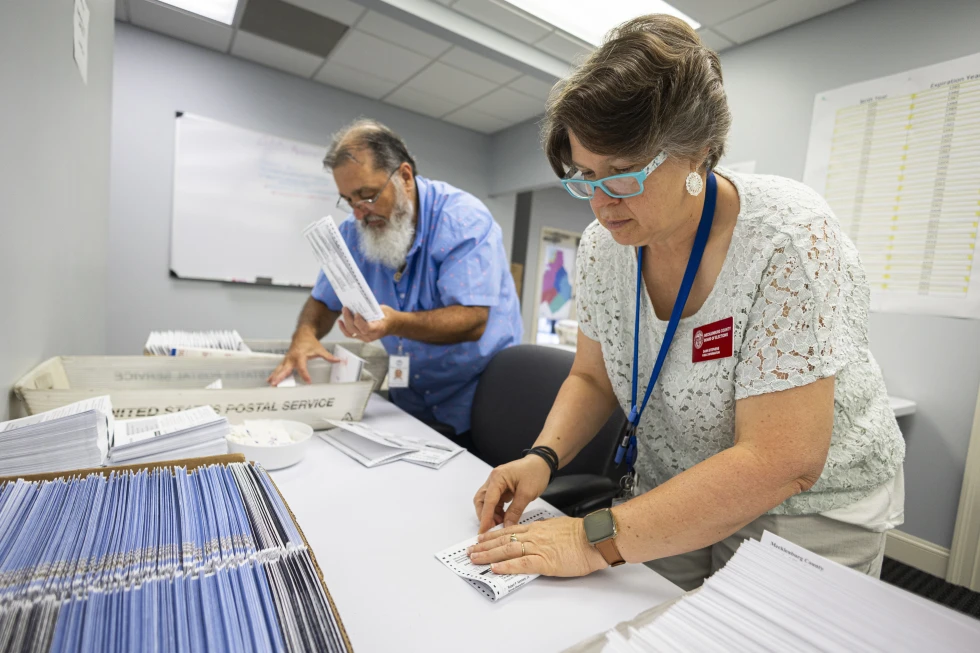
In Georgia, election workers will have to hand count the number of ballots cast after voting is completed. In North Carolina, some students and university staff can use their digital IDs to vote. In Wisconsin, ballot drop boxes are newly legal again, although not every voting jurisdiction will use them.
Across the country, including in some of the nation’s presidential swing states, new or recently altered state laws are changing how Americans will vote, tally ballots, and administer and certify November’s election.
It can be a challenge to keep track of these 11th-hour changes, especially since state election processes already vary so widely. Even more changes are looming in some states, with Election Day on Nov. 5 now just weeks away. Several states already have started sending out mail ballots, and in some states, voters have begun casting ballots in person.
“Last-minute changes to election rules — whether from a state legislature, an election authority or a court — can lead to confusion for voters and election officials,” Megan Bellamy, vice president of law and policy for the Voting Rights Lab, said in an email response. “Election season is underway. Lawmakers, administrative bodies and courts must recognize that.”
Here’s a look at some of the election processes that are new or have been recently modified.
New hand-counting requirements
Georgia and Arizona will both require election workers to hand-count ballots at polling sites on Election Day. Election officials say it could delay the reporting of results.
The Georgia State Election Board passed its new rule on Friday. It requires that the number of ballots — not the number of votes — be counted by hand at each polling place by three separate poll workers until all three counts are the same.
Georgia voters make selections on touch-screen voting machines that print out paper ballots. Those ballots include a list of the selections so voters can verify their accuracy and a QR code that is read by a scanner to tally the votes.
Proponents say the new hand-count rule is needed to make sure the number of paper ballots matches the electronic tallies on scanners, check-in computers and voting machines. The three workers will have to count the ballots in piles of 50, and the poll manager needs to explain and fix, if possible, any discrepancies, as well as document them.
The rule goes against the advice of the state attorney general’s office, the secretary of state’s office and an association of county election officials. Critics worry it could delay the reporting of election night results, undermining public confidence in the process.
A similar change to state law this year in Arizona is also likely to cause delayed results in the swing state this fall. It requires counties to hand count ballot envelopes that are dropped off at polling centers on Election Day before the ballots are tabulated.
After the July primary, Maricopa County Elections spokesperson Jennifer Liewer said the new step resulted in a roughly 30-minute delay in reporting the county’s results, and said the impact could be greater in the general election “if we have hundreds of thousands of ballots dropped off.”
Maricopa County, which includes Phoenix, estimates between 625,000 and 730,000 voters will drop off their ballots on Nov. 5.
JP Martin, a spokesperson for Arizona Secretary of State Adrian Fontes, a Democrat, said in an email that the ballot counting mandate will “require considerable time, particularly since poll workers have already completed a 12-15-hour shift.”
Changes for early and mailed ballots
Chaos and disinformation about mail-in ballots and drop boxes have prompted partisan disagreements — and new rules — in several states over how these accessible voting methods should be used.
In Wisconsin, the then-conservative majority state Supreme Court outlawed drop boxes in 2022. But a new liberal majority on the court made them legal again in July. Some communities opened them for the state’s August primary, but more will be in use for November.
Their use in Wisconsin is voluntary and some conservative towns have opted against using drop boxes, citing security concerns. The state’s two most heavily Democratic cities, Milwaukee and Madison, used them in August and will again in November.
Ohio Secretary of State Frank LaRose, a Republican, issued a directive to county election boards in August that said only a voter can drop their personal ballot in a drop box. Anyone who assists someone else must return that ballot inside the county board office and complete an attestation form.
In Pennsylvania, a court battle is pending at the state Supreme Court that could decide whether counties must count provisional ballots cast by voters whose mail-in ballots were rejected for relatively minor mistakes, such as not inserting the ballot into an inner secrecy envelope. Practices vary by county and state law is silent on it. Republicans have argued that nothing in state law explicitly allows a voter to cast a provisional ballot in place of a rejected mail-in ballot.
Separately, the Pennsylvania state Supreme Court earlier this month threw out a case on a technicality after a lower court had ruled that rejecting mail-in ballots for “meaningless and inconsequential paperwork errors” — such as a missing handwritten date — violates the constitutional right to vote. As a result, counties are expected to continue the practice of disqualifying those ballots. Some counties — primarily Democratic ones — strive to help voters fix those errors or cast a provisional ballot instead.
This is the first presidential election since Florida’s Republican-controlled Legislature made a series of changes to mail balloting in 2021. While those aren’t recent changes, their impact could be significant this year in a state that traditionally has had robust interest in voting by mail. One change makes a voter’s request for a mail ballot valid only for the next general election, rather than two general election cycles, meaning voters will have to reapply. Requesting a mail ballot also now requires a driver’s license number, state ID number or last four digits of a Social Security number.




